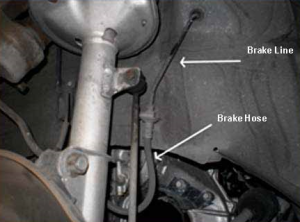 Hydraulic brakes most commonly consist of a few components including a brake pedal, a pushrod, a master cylinder assembly, reinforced hydraulic lines, and a brake caliper assembly. Brake lines, typically made of double walled steel tubing, and brake hoses are vital for the proper operation of a vehicle but, like other parts, will experience wear and tear and need to be replaced.
Hydraulic brakes most commonly consist of a few components including a brake pedal, a pushrod, a master cylinder assembly, reinforced hydraulic lines, and a brake caliper assembly. Brake lines, typically made of double walled steel tubing, and brake hoses are vital for the proper operation of a vehicle but, like other parts, will experience wear and tear and need to be replaced.
Brake lines are connected to each wheel at the brake caliper and run into the engine compartment. Brake hoses can typically be found between the wheels, axles, and the frame. Leaks in either lines or hoses can be visually seen or felt by running your hand along exposed lines. Brake hoses, additionally, should be dry, firm, and free of cracks or flaking. If the hoses are cracked or flaking, it’s a good sign that they should be replaced.
When it comes time to do some work on your brake hoses and lines, it can sometimes be tempting to consider repairing your hoses rather than replacing them. However, you should always replace rather than repair hoses. In fact, even connectors like the brass washers should be replaced every time you replace your brake hoses.
When it comes to actually choosing a hose there are four things that you must consider. First, any hose that you use should be customized to your vehicle make and model. Second, the hose should be manufactured in compliance with federal standards. Third, it is essential that the hose is compatible with standard fittings and adapters. Fourth, the hose should work with all standard brake fluids.
For more information on brake hose, click here.